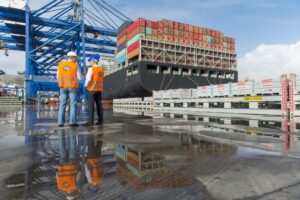Digitalisation makes data more accessible across all aspects of the maritime and port business. It has become a imperative to turn opinions into facts, facts into insights, and insights into actions, to stay ahead of the competition. An agent‘s perspective.[ds_preview]
The shipping industry is rapidly taking on the benefits of digitalisation – real-time location tracking for vessels, artificial intelligence and machine learning for crewless ships and unmanned vessels, smart sensors for predictive maintenance, and virtual reality for training seafarers. Data is at the core of these developments.
Shipping companies are now increasingly turning to suppliers for data and insights to support their critical decision-making.
Take the delivery of spare parts for example. In the past, information on the status of spare parts was held by marine logistics providers responsible for picking, storing and consolidating them for delivery to vessels and offshore platforms. Now, asset owners and operators want status reports at their fingertips in their own systems, giving them greater operational control and enabling them to address poor supply chain performance to boost productivity and safety. Notably, the pandemic accelerated this change with increased work-from-home demands.

Looking ahead, data sharing will become even more crucial as the industry further picks up the pace of digitalisation. Based on a report by the World Bank and the International Association of Ports and Harbors World, the »creation of an efficient digital ecosystem would go a long way in streamlining operations and facilitating the exchange of data between shipping lines, port services, cargo handling operations, clearance agencies, and with other transport networks.«
The European Commission has introduced regulations to implement a fully operational European Maritime Single Window (EMSW) by 2025. The EMSW will link the existing national maritime single windows together to harmonise digital reporting for ships and facilitate effective data sharing among operators in an integrated and seamless manner across member states of the European Union. Once completed, effectively used and shared data will reduce the need for manual data entry, optimise cargo flows and serve the whole logistics chain while increasing the competitiveness of the European maritime transport sector and promoting sustainable shipping.
Data quality
Standalone data serves little purpose until it is extracted, refined and transformed into meaningful, useful analytics in a specific context. It is said that data is the most important asset in a company – but it has to be quality data. The problem with data in the shipping industry is that it is spread across multiple systems, companies or governments, and the historical data is mostly of poor quality.
To ensure the seamless flow of data across the industry, we need to work together to give the shipping industry a data standard – just as the International Air Transport Association (IATA) has done with the development of data standards for the aviation industry.
The better the data quality, the more benefits it brings to the business. Turning towards digital documents, such as automated data scanning of passports for crew changes, enables to not only optimise data quality but also streamline processes, reduce errors caused by manual data entry, minimise delays, and comply with regulations, all while reducing the carbon footprint of both the organisation and its customers.
System integration
There are two preconditions to delivering meaningful insights to customers: system integration and data sharing. Increasingly listed as criteria in new tender requirements. Businesses now expect closer collaboration with service providers and a smooth and consistent flow of information across stakeholders within the same supply chain.
GAC’s Pegasus customer portal for example provides large international customers with real-time information about port infrastructure, services available, mishaps, accidents, delays and turnaround times. With access to data on 220,000 vessels and all ports around the world, users can predict and avoid port congestion, pick the best routes and make informed voyage decisions based on efficiency, time and financial considerations even before booking shipping services, in turn reducing fuel consumption and improving environmental sustainability. In another instance, GAC integrated its in-house system and internal data with commercial off-the-shelf technologies to provide customers, suppliers and regulatory authorities with insights on key supply chain events to facilitate the collective tracking and tracing of pharmaceutical goods.
Cyber security
As our industry embraces digitalisation, we should also be mindful of the risks it brings. Since the start of the pandemic, cyber threats have increased – cyber criminals are exploiting new vulnerabilities and targeting employees working from home who lack the instant feedback on suspicious emails and other threats provided by colleagues in a physical setting.
As integrated digital systems become more sophisticated, so do cyber criminals. The human link simultaneously represents both the greatest weakness and the best protection. That’s why training and equipping people for the changing world of work, as well as investing in IT security, is key to staying ahead. There are also international standards to support organisations in implementing robust information security policies such as the ISO/IEC 27001 Information Security Management Certification acquired by GAC in April this year.
Ultimately, digitalisation is about achieving good data quality, effective decision-making, operational efficiency and time and cost savings – all of which are enablers of compliance and sustainability. Ship agents are well positioned to play a key role in helping customers seize the opportunities digitalisation brings to the future of shipping.
Author:
Martin Wallgren
Chief Information Officer
GAC Group



















